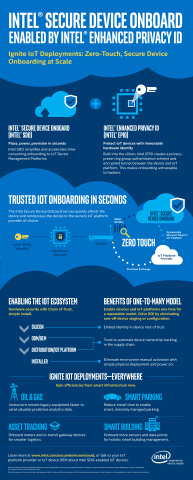Solution Addresses Critical Issues of Bringing Large-Scale Internet of Things Deployments Online and Securely Managing Devices and Data
BARCELONA, Spain — (BUSINESS WIRE) — October 3, 2017 — At the IoT Solutions World Congress, Intel (NASDAQ: INTC) addressed the challenges facing the Internet of Things (IoT) market today, and made a critical announcement designed to empower the industry to make the most of the tremendous opportunities ahead.
This press release features multimedia. View the full release here: http://www.businesswire.com/news/home/20171003005493/en/

The Intel Secure Device Onboard technology simplifies and accelerates time-consuming onboarding of Internet of Things (IoT) devices. (Credit: Intel Corporation)
While earlier reports claimed that we will see 50 billion IoT devices by 2020, the reality is we are nowhere close to reaching those numbers. In fact, recent research reports are far more tempered and predict closer to 30 billion devices in the same timeframe. The reason for the scaled-down outlook is because of the real-time issues of scaling deployments and security.
Today, provisioning and management of devices is a huge challenge, as IoT devices are added manually. It involves coordination between installation technicians, IT network operations, and operational technology teams and can typically take more than 20 minutes for a single device. Imagine installing 10,000 “smart IoT” light bulbs – at present, it could take two years to complete the process. This is to say nothing of the effort required to maintain device privacy and security.
To solve these complex issues, today Intel announced the launch of Intel® Secure Device Onboard (Intel® SDO). This technology securely automates and brings IoT devices online within seconds rather than hours. Intel SDO is being offered to IoT platform providers as a service they can provide to customers who wish to onboard thousands of connected devices.
More: Intel Secure Device Onboard (Product Brief)
Intel SDO’s “zero touch” model allows devices to dynamically discover the customer’s IoT platform account at power-on for automatic registration. It offers a one-to-many, one-time enablement solution that can be integrated into almost any device or IoT platform, thereby eliminating the need to custom pre-load provisioning configurations for each IoT implementation.
The Intel SDO also leverages Intel’s unique privacy-preserving IoT identity solution, the Intel® Enhanced Privacy ID (Intel® EPID), to anonymously authenticate the device and establish an encrypted communication tunnel, thereby preventing hackers from tracing the device from factory to owner. Intel EPID establishes a best practice identity model for IoT onboarding and is a proven method with over 2.7 billion keys distributed in Intel and non-Intel MCU processors since 2008.
Intel has expanded the availability of Intel SDO across the IoT ecosystem. Other silicon providers like Infineon, Microchip and Cypress Semiconductor will embed the EPID identity capability in their hardware. Cloud service platform and device management software providers like Google Cloud, Amazon Web Services (AWS), Microsoft Azure and Intel’s Wind River® Helix™ Device Cloud intend to provide integration to support Intel SDO’s zero touch model.
Intel SDO is now integrated with Wind River Helix Device Cloud, its device lifecycle management platform that enables IoT devices to securely connect, monitor, manage and service devices. With the integration of Intel SDO, Wind River’s latest release of Device Cloud includes zero touch onboarding designed to mitigate the risk of security attacks to a device, ensure privacy and deliver automation that dramatically reduces installation and onboarding time to mere seconds, among other new features and capabilities.
Weatherford, a leading oil and gas services company, was part of the Intel SDO pilot program. The company wanted to pull data from existing controllers and install new wireless sensors through a gateway to the cloud to drive oil and gas insights. By adopting the Intel SDO and Wind River’s Device Cloud, Weatherford was able to create a secure, scalable oilfield ecosystem from zero-touch onboarding to continual gateway management. It projects the sheer scale of the market for managed devices could reach 290,000 wells, representing 870,000 sensor data points and nearly 10,000 IoT gateways at a global level.
With these new offerings, Intel is at the forefront of developing cutting-edge solutions to deliver on the promise of IoT’s potential.
For more details on Intel’s keynote at the IoT Solution World Congress visit Intel’s IoT Solutions World Congress page or to find our more about becoming part of the Intel SDO ecosystem, go to Intel Secure Device Onboard page.
View source version on businesswire.com: http://www.businesswire.com/news/home/20171003005493/en/
Contact:
Intel Corporation
Danielle Mann
Email Contact








